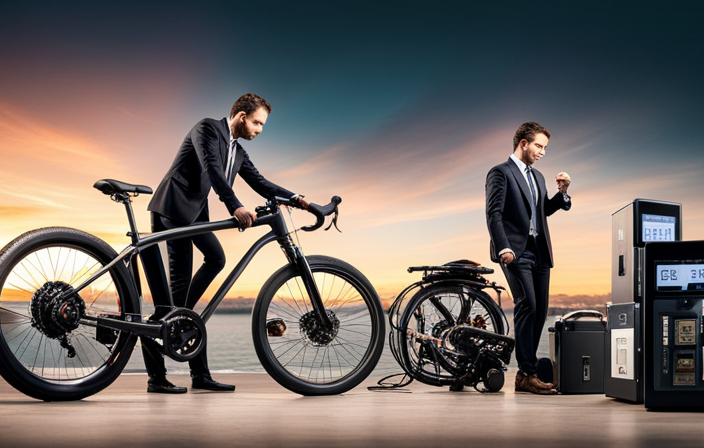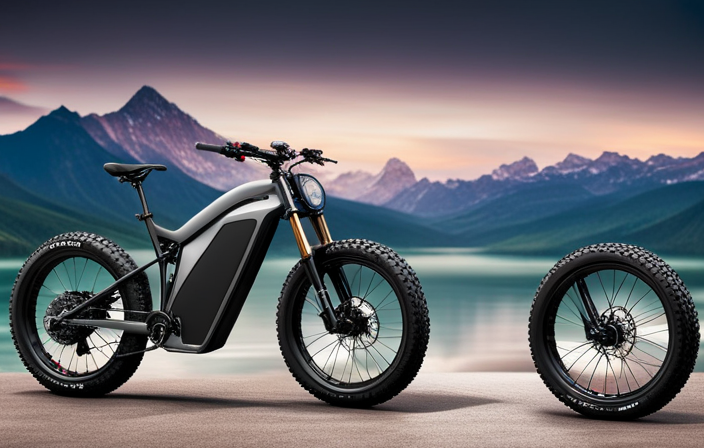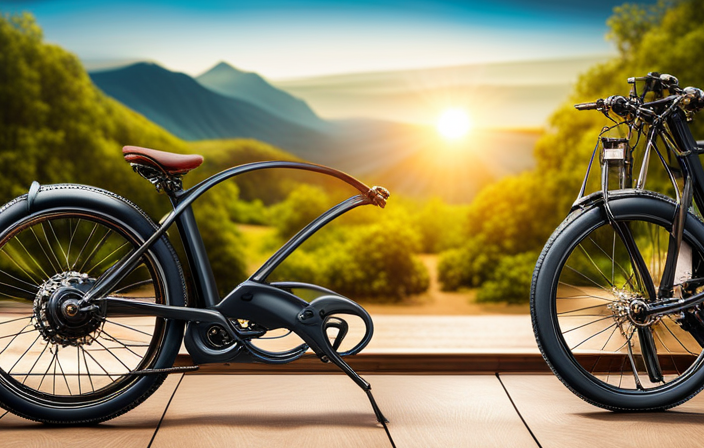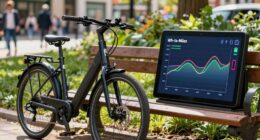Considering converting your bike to electric? You’re in good company. Electric bike conversions are gaining popularity for a reason – picture smoothly riding up hills and effortlessly covering long distances.
But before you embark on this electrifying journey, it’s important to consider the costs involved. In this article, I’ll break down the factors that contribute to the total cost of making your bike electric, helping you make an informed decision based on your budget and needs.
Let’s dive in!
Key Takeaways
- Consider bike type and compatibility when choosing a conversion kit.
- Calculate power requirements based on weight, terrain, and desired speed.
- Research and compare prices, warranties, and customer reviews before making a decision.
- Factor in additional expenses for accessories and installation costs.
Understand the Basics of Electric Bike Conversion
To understand the basics of electric bike conversion, you’ll need to learn about the different components involved.
When it comes to converting your regular bike into an electric one, there are several conversion kit options available. These kits typically include a motor, a battery, a controller, and a display.
The motor is responsible for providing the extra power needed to propel the bike forward, while the battery stores the energy to power the motor. The controller acts as the brain, regulating the flow of electricity, and the display shows important information such as speed and battery level.
The benefits of electric bike conversion include increased speed and range, easier uphill climbs, and the ability to commute or ride longer distances without getting tired.
Understanding these basic components will help you choose the right conversion kit for your bike, ensuring a successful and efficient electric bike conversion.
Choose the Right Conversion Kit for Your Bike
When choosing a conversion kit for my bike, it’s important to consider the type of bike I have. Different kits are designed for different types of bikes, such as mountain bikes or road bikes, so I need to make sure I choose one that is compatible with my bike’s frame and components.
Additionally, I need to determine my power and range needs. This involves considering factors such as the terrain I’ll be riding on, my weight, and the distance I plan on traveling.
Lastly, I need to take into account the weight and size of the kit. This is important because it can affect the handling and performance of my bike, so I need to choose a kit that is lightweight and compact, while still providing the power and features I need.
Consider the Type of Bike You Have
Before deciding to convert your bike to electric, consider the type of bike you’ve got. The bike frame and battery compatibility are crucial factors in determining if your bike is suitable for an electric conversion. Here are a few things to keep in mind:
-
Bike Frame: Electric conversion kits are generally designed to fit standard bike frames. It’s important to ensure that your bike frame is compatible with the conversion kit you choose. Some kits may require specific frame types or sizes, so double-check the compatibility before making a purchase.
-
Battery Compatibility: Different conversion kits may have different battery requirements. Make sure your bike can accommodate the battery size and weight of the conversion kit you plan to install. Consider the available space on your bike frame for mounting the battery and ensure it won’t interfere with other components.
Considering these factors will help you determine if your bike is suitable for an electric conversion. Once you’ve assessed your bike’s compatibility, the next step is to determine your power and range needs.
Determine Your Power and Range Needs
Once you’ve figured out if your bike is compatible for conversion, it’s important to determine how much power and range you’ll need. Calculating power requirements involves considering factors such as your weight, the terrain you’ll be riding on, and how fast you want to go. If you plan on tackling hilly terrain or want to reach higher speeds, you’ll need a more powerful motor.
Estimating battery capacity is crucial for determining how far your electric bike can take you. This depends on factors like your average speed, the weight you’ll be carrying, and the type of battery you choose.
Take into account the weight and size of the kit, as this can affect the overall performance and handling of your bike.
Take into Account the Weight and Size of the Kit
Calculating power requirements involves considering factors like my weight, the terrain I’ll be riding on, and how fast I want to go.
When it comes to cost considerations for making my bike electric, battery options play a crucial role. The cost of the conversion kit largely depends on the battery type and size.
Lithium-ion batteries are the most common choice due to their lightweight and high energy density. However, they can be more expensive compared to lead-acid batteries. Additionally, the capacity of the battery affects the range and power output of the electric bike. It’s important to balance cost and performance when choosing a battery option.
Transitioning into the next section, researching and comparing conversion kit prices will help me find the best option for my budget and needs.
Research and Compare Conversion Kit Prices
You can easily research and compare conversion kit prices to find the best deal for making your bike electric.
When it comes to conversion kit options, there are various brands and models available in the market. It is important to compare prices to ensure you are getting the most value for your money.
Start by looking up different online retailers and check if they offer any discounts or promotions. Read customer reviews to get an idea of the quality and performance of the conversion kits. Additionally, consider factors like warranty, installation support, and customer service.
Once you have compared prices and chosen the right conversion kit, you can then factor in additional accessories to enhance your electric bike experience.
Factor in Additional Accessories
Consider exploring various accessories that can enhance your electric biking experience. Adding additional accessories to your electric bike can not only improve its functionality but also make your rides more comfortable and enjoyable.
Here are some accessories to consider:
- Panniers or baskets: These can provide extra storage space for carrying your belongings.
- Lights: Ensure your safety and visibility on the road, especially during nighttime rides.
- Fenders: Keep yourself dry and protect your bike from mud and water splashes.
- Phone mount: Conveniently access navigation or fitness tracking apps while riding.
When estimating the cost of making your bike electric, don’t forget to factor in the expenses for these additional accessories. While the prices may vary depending on the brand and quality, it’s essential to consider these costs to have a complete estimation.
Now, let’s transition into the next section and explore the installation costs you should also take into account.
Consider Installation Costs
When considering the installation costs of converting your bike to electric, there are a few key points to keep in mind.
First, you’ll need to decide whether you want to tackle the installation yourself or hire a professional. DIY installation may save you money, but it requires technical skills and knowledge.
Researching local bike shops and mechanics can help you find experienced professionals who can ensure a proper installation.
Don’t forget to get quotes for installation services from different providers to compare prices and make an informed decision.
DIY vs. Professional Installation
If you’re unsure about your technical skills, it’s worth considering professional installation for your electric bike conversion. While some people enjoy the challenge of doing it themselves, there are advantages to having a professional handle the installation.
Here are four reasons why professional installation may be the better option:
-
Expertise: Professionals have the knowledge and experience to ensure that the conversion is done correctly and safely.
-
Time-saving: Hiring a professional can save you a significant amount of time, as they are familiar with the process and can complete the installation efficiently.
-
Warranty: Many professional installers offer warranties on their work, giving you peace of mind in case anything goes wrong.
-
Customization options: Professionals can provide customization options that may not be available in DIY kits, allowing you to tailor your electric bike to your specific needs.
Considering these advantages, it’s important to research local bike shops and mechanics who specialize in electric bike conversions.
Research Local Bike Shops and Mechanics
After considering the pros and cons of DIY versus professional installation, it’s time to dive into researching local bike shops and mechanics for electric bike conversions.
This step is crucial in finding the right experts who can provide the necessary expertise and guidance throughout the process. Start by gathering a list of local bike shops and mechanics in your area.
Look for those with experience and knowledge in electric bike conversions. Additionally, compare pricing for electric bike conversion kits at different shops and mechanics. Some may offer competitive prices or even package deals that include installation services.
By doing thorough research, you can ensure that you find a reputable shop or mechanic that not only offers quality conversion kits but also provides reliable installation services.
With this information in hand, it’s time to move on to the next step: getting quotes for installation services.
Get Quotes for Installation Services
To get quotes for installation services, start by reaching out to different local bike shops and mechanics in your area who specialize in electric bike conversions. When considering an installation service, it’s important to weigh the benefits of DIY installation versus hiring a professional.
While doing it yourself can save money, it requires technical knowledge and tools. Factors to consider when choosing an installation service include their experience with electric bike conversions, reputation, and pricing. Reach out to multiple shops to compare quotes and services offered. Some shops may offer additional benefits like warranty or post-installation support.
Once you have gathered all the quotes, you can calculate the total cost of conversion, including the cost of the electric bike kit and any additional parts or accessories needed. This will help you make an informed decision and ensure a successful electric bike conversion without breaking the bank.
Calculate the Total Cost of Conversion
You can calculate the total cost of converting your bike to electric by adding up the prices of the battery, motor, and any additional components. Here is a cost breakdown to help you plan your budget:
- Battery: The most expensive component, costing anywhere from $500 to $1,500 depending on the capacity and quality.
- Motor: Prices range from $200 to $800, depending on the power and brand.
- Controller: This device manages the motor’s speed and power, costing around $100 to $300.
- Conversion Kit: Includes all the necessary components like wiring, connectors, and throttle, with prices ranging from $100 to $500.
- Installation: If you’re not comfortable doing it yourself, expect to pay around $200 to $500 for professional installation.
To save on costs, consider these tips:
- Look for sales or discounts on components.
- Consider buying used parts in good condition.
- Compare prices from different suppliers.
- Do the installation yourself if you have the skills.
- Research DIY conversion guides and tutorials online.
Explore Financing Options and Incentives
After calculating the total cost of converting my bike to electric, I was excited to explore financing options and government incentives that could make the process more affordable.
One financing option that caught my attention was the availability of low-interest loans specifically designed for electric vehicle conversions. These loans could help cover the upfront costs and allow me to pay them back over time.
Additionally, I discovered that some states and municipalities offer financial incentives, such as rebates or tax credits, to encourage the adoption of electric transportation. These incentives vary depending on where you live, so it’s important to research what is available in your area.
By taking advantage of these financing options and government incentives, I could significantly reduce the overall cost of converting my bike to electric.
This brings me to the next important aspect: evaluating the return on investment.
Evaluate the Return on Investment
Calculating the potential return on investment for converting my bike to electric is essential to determine if the financial benefits outweigh the upfront costs. It’s important to evaluate the potential savings and analyze the environmental impact of this conversion.
Here are three key factors to consider:
-
Fuel savings: By switching to an electric bike, I can save money on fuel costs. Electric bikes are more energy-efficient compared to traditional bikes, and I won’t have to spend on gasoline or other fuels.
-
Maintenance costs: Electric bikes generally have lower maintenance costs. With fewer moving parts and no need for oil changes, the overall maintenance expenses can be reduced.
-
Environmental impact: Going electric means reducing my carbon footprint. Electric bikes produce zero emissions, contributing to cleaner air and a healthier environment.
Considering these factors, it’s clear that evaluating the return on investment is crucial before making the decision to convert my bike to electric. To gain more insights, consulting with electric bike enthusiasts and experts can provide valuable information and guidance.
Consult with Electric Bike Enthusiasts and Experts
After evaluating the return on investment, I realized that converting my bike into an electric one could be a worthwhile endeavor. However, I wanted to gather more information and insights from electric bike enthusiasts and experts before making a decision.
Consulting with these individuals would not only help me understand the benefits of electric bike conversion but also provide valuable guidance on the challenges I might face during the process. By reaching out to enthusiasts and experts, I could gain a deeper understanding of the technical aspects, such as choosing the right motor and battery for my bike, as well as the potential costs involved.
Their expertise would enable me to make an informed decision based on my budget and needs, ensuring that I choose the most suitable conversion option.
Make an Informed Decision Based on Your Budget and Needs
To ensure you choose the most suitable option, it’s important to consider your budget and needs when making an informed decision.
When it comes to making your bike electric, budget considerations and performance features are crucial factors to take into account. Electric bike conversion kits can range in price from $200 to $2,000, depending on the quality and features.
It’s essential to evaluate your budget and determine how much you are willing to invest in converting your bike. Additionally, you should assess the performance features that are important to you, such as motor power, battery range, and charging time.
These considerations will help you make an informed decision and choose the electric bike conversion kit that best fits your budget and meets your performance needs.
Frequently Asked Questions
What are the benefits of converting a regular bike into an electric bike?
Converting a regular bike into an electric bike has numerous benefits. It provides the advantages of owning an electric bike, such as increased speed and range, easier hill climbing, and the ability to commute without getting exhausted.
Are there any specific requirements for the bike in order to be eligible for conversion?
To be eligible for conversion, your bike needs to meet certain requirements. Specific bike requirements include a sturdy frame, compatible wheel size, and enough space for the battery and motor.
Can I convert any type of bike into an electric bike, or are there limitations?
There are limitations to converting a folding bike into an electric bike due to its compact size and design. Converting a mountain bike into an electric bike requires considerations such as frame strength and suspension compatibility.
Are there any maintenance costs associated with owning an electric bike?
Owning an electric bike does come with maintenance costs. Regular maintenance, such as checking the battery, tires, and brakes, is necessary. It’s also important to follow manufacturer guidelines for charging and storage to ensure longevity and performance.
What is the average lifespan of an electric bike after conversion?
The average lifespan of an electric bike after conversion is around 5-10 years. However, it can vary depending on the quality of components used and the level of maintenance. Regular maintenance can help extend the lifespan and reduce overall costs.
Conclusion
After thoroughly researching the costs involved in converting my bike to electric, I have come to a well-informed decision.
Taking into account the basics of electric bike conversion, the right conversion kit for my bike, and additional accessories, I have estimated the total cost.
While installation costs and financing options should also be considered, it ultimately comes down to evaluating the return on investment.
Consulting with electric bike enthusiasts and experts has been invaluable in guiding my decision-making process.
With all factors considered, I am excited to embark on this journey and join the electric bike revolution.
It’s time to pedal into the future!









